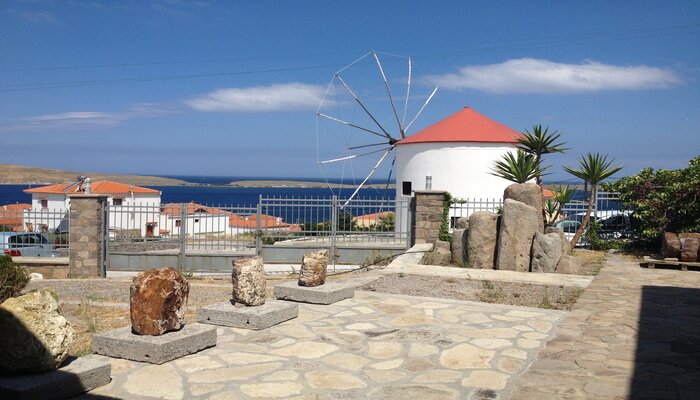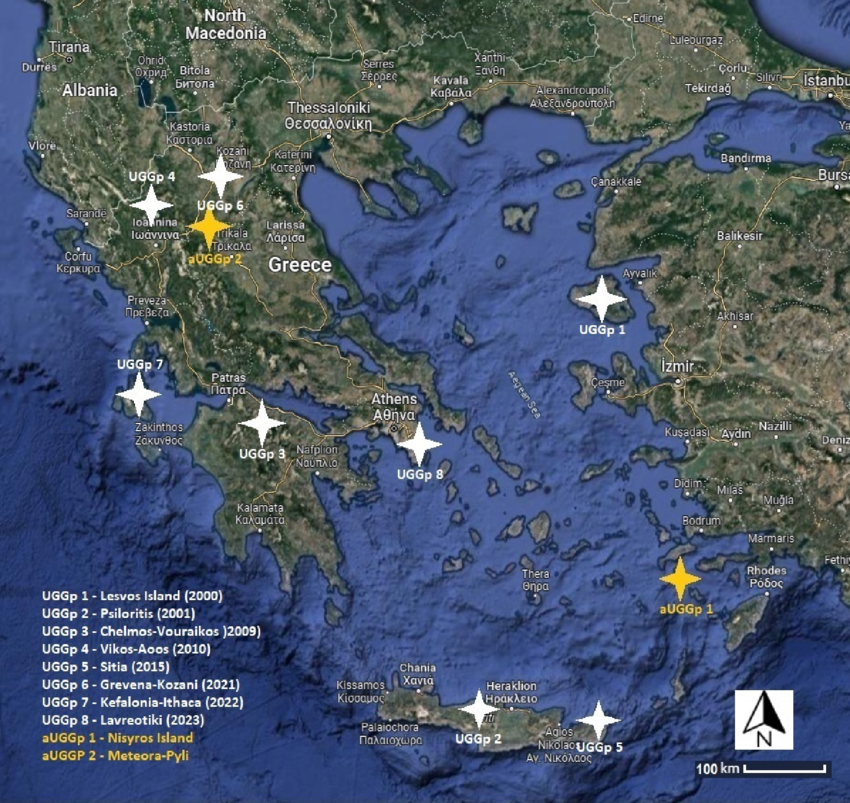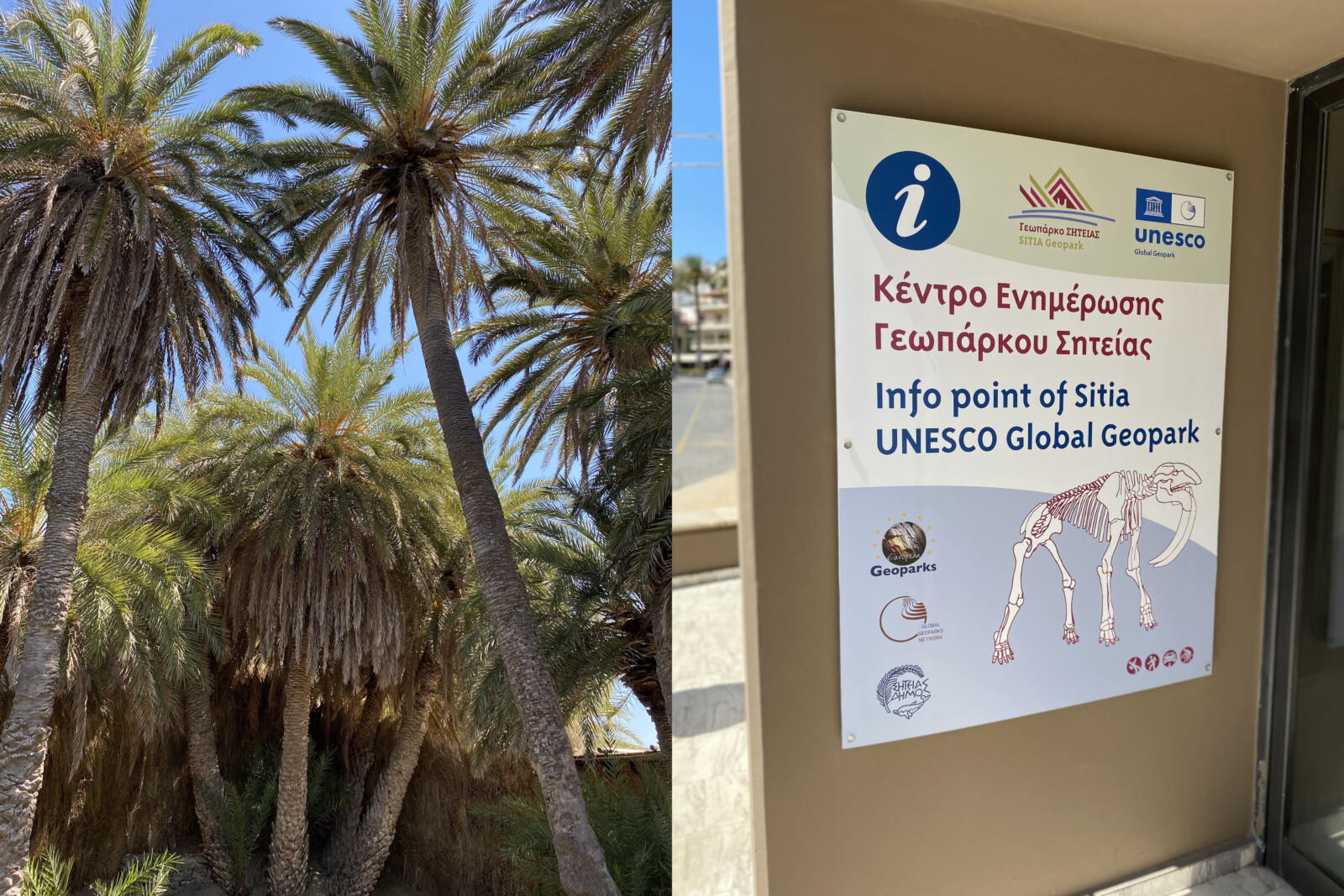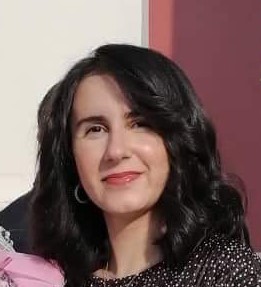
Have you started planning your summer holidays, or do you desperately need to escape work? Well, rest assured we’ve got you all covered. In this week’s blog, we aim to take you on a Geojourney around the most diverse and spectacular Geoparks you can visit, the next time you travel to Greece.
Greece is well known as one of the top travel destinations around the world with its dreamy sandy beaches, shimmering blue waters, and an amazing local food scene that can tempt even the harshest of critics. However, let’s not forget that Greece has also a rich natural, as well as cultural heritage that needs to be promoted and preserved through the course of time (Zafeiropoulos et al., 2021).
For that reason, there is a specific network that serves to inform, advocate, preserve, and protect the scientific community as well as the general public about geographical areas of unique biodiversity or of geological importance for the international community (UNESCO Global Geoparks). This is widely known as the UNESCO Global Geoparks Network, which was founded back in 2004 to foster the concept of natural and geological heritage, sustainable development, and public education (Zouros, N. and Martini, G., 2003). At the present time, there are 213 UNESCO Global Geoparks in 48 countries.
But what makes Greece so special? Well, without doubt, its geotectonic position has contributed immensely to all the geological formations and processes that we are able to see today; being right at the centre of a convergent zone between the African and Eurasian plates and right in front of the last vestiges of an ancient seabed slowly disappearing by the movement of the African plate, has played a crucial role in creating an open to the public geological museum of some of the most important evolutionary features of our planet (Koupatsiaris and Drinia, 2023). Consequently, Greece provides an exemptional case of a ‘’natural geological laboratory’’ that allows many scientists and the public as well to explore and identify various geological phenomena such as volcanic activity, landscape evolution, and tectonic processes (Rassios et al., 2020).
For all the above reasons, Greece has been a proud member of the UNESCO Global Geoparks Network since 2004 to advocate and promote these recognised Geoparks and their activities at a local and international level. At the moment, there are registered eight Greek UNESCO Global Geoparks in total, which can be depicted in the map below:

This map shows the locations of the Greek UNESCO Global Geoparks and aspiring Geoparks (Koupatsiaris and Drinia, 2023).
These already recognised Greek UNESCO Geoparks are paving the way for a bright future ahead promoting the natural and cultural heritage of Greece worldwide. It is also worth mentioning that there are still hidden geological treasures that are waiting to be discovered. Hence, we are convinced that there will be new contributions of more Greek UNESCO Geoparks to come in the forthcoming years.
In this blog, it was hard to choose amongst all of the listed Greek geoparks that you should pay a visit to once in your life if you ever happen to be in Greece. However, after careful consideration (and my humble personal experience), we have come to present to you the top three Greek Geoparks that are absolutely worth your time and money!
1. Lesvos Island UNESCO Global Geopark

Petrified roots of fossilised trees preserved in full growth at Sigri Petrified Forest-Left (Left photo: Kleoniki Lydia Theodoridou). The Petrified Forest Park in Bali Alonia is the first outdoor park to visit the Petrified Forest-Right (Right photo: Lesvos Geopark).
The UNESCO Global Geopark of Lesvos Island, previously known as the Lesvos Petrified Forest Geopark is a founding member of the Geoparks Network since 2004, attracting thousands of tourists not only for the impressive rare geological monuments but also for the archaeological and cultural heritage of the island (LESVOS ISLAND UNESCO GLOBAL GEOPARK-Global Network of National Geoparks).
Lesvos is the third largest Greek island with an area of 1.636 km2 and 370 km of coastline, and the seventh largest in the Mediterranean. The island is located in the NE Aegean Sea close to the coast of Asia Minor and features one of the most well-preserved petrified forest parks all over the world, mainly because of an enormous volcanic eruption that occurred 20 million years ago (Zouros, N. 2010).
As a result, the whole landscape was covered, in the aftermath of the volcanic eruption, by ashes and other volcanic and clastic materials, by the geologists named pyroclastic, and the subsequent rainfalls and mudflows of more materials led to vast forests being buried underneath them (LESVOS ISLAND UNESCO GLOBAL GEOPARK-Global Network of National Geoparks.). It is quite remarkable that to this day, we can see such majestic root systems, and well-preserved standing and falling fossilised trunks in all four parks of the Lesvos Petrified Forest (Bali-Alonia Park, Sigri Park, Plakas Park, Nissiopi Park, and the fossil sites along the Antisa-Sigri road) (Lesvos Geopark).
Apart from the Petrified Forest, there are other things that you can see while you are exploring Lesvos Island. For example, you can pay a visit to the National History Museum of the Petrified Forest, where you can learn more about the geological past of the island, admire impressive animal fossils that lived on the island 2 million years ago, or even take part in outdoor activities such as picturesque georoutes or hiking trails across the island.
Video (Credit: Lesvos Geopark)
https://youtu.be/0tfX8NK3Nnc?si=YOMR6IvUOxxkWOza
2. Lavreotiki UNESCO Global Geopark

Temple of Poseidon at Sounio, one of the most spectacular and historical cultural sites in the area -Left Underground tunnel at the Lavrion silver mines-Right (photos: Lavreotiki Geopark).
The Lavreotiki UNESCO Global Geopark was founded in 2023 and is comprised of Lavrion town covering approximately 177 km2. It is located close to the capital city of Greece, Athens, and is considered one of the most diverse and rich regions in terms of geological, cultural, and archaeological aspects (Panagiotis Voudouris et al., 2021). Today, the region is home to 25,102 people and has been intensely inhabited since antiquity due to its underground geological treasures (Lavreotiki UNESCO Global Geopark-Global Network of National Geoparks).
The Geopark’s presence has been influenced all over the world because of its great value mines in Lavrion. It is important to highlight that the Lavrion deposit contains five different styles of deposits related to each other, which is something extraordinary and can only be seen in the area. In addition, what makes it even more special is that its minerals accommodate the highest number of elements of any known mining district, and hence, are more diverse than anywhere else in the world (Panagiotis Voudouris et al., 2021).
Another significant factor that contributed to this outstanding mining region was the climate conditions and their contribution in the formation of an environmental setting, aiding in the formation of multiple new and unique, through oxidation, secondary nano-minerals. At present, almost 12 % of the globally known mineral species can be found in the Lavreotiki UNESCO Global Geopark, making it an exemptional natural mineralogical museum (Panagiotis Voudouris et al., 2021).
Except for its outstanding silver mining industry, many other sites can be discovered in the area. For instance, you can take one of the many different geotrails and start discovering monuments of valuable geological and archaeological importance such as the ancient temple of Poseidon in Sounio as well as the Natural Park, which is a remarkable place of flora and fauna of the Lavreotiki region.
Video (Credit: Lavreotiki Geopark-Municipality of Lavreotiki)
https://youtu.be/G8eacRNven8?si=hv8v8BWYt2-xpN5H
3. Sitia UNESCO Global Geopark

The Cretan palm date grove of Vai, the only date palm (Phoenix theophrasti) forest in Europe- Left; (SITIA UNESCO GLOBAL GEOPARK -Global Network of National Geoparks); Information point of Sitia UNESCO Global Geopark in the city centre of Sitia-Right (photos: Kleoniki Lydia Theodoridou).
The Sitia UNESCO Global Geopark was founded in 2015 and is located on the eastern edge of Crete, covering an area of 512 km2. It is mainly a mountainous region, where in the centre and southwest Mount Zakros dominates the landscape, whilst in the east there are steep cliffs and slopes (SITIA UNESCO GLOBAL GEOPARK -Global Network of National Geoparks).
The Geology of the Sitia UNESCO Global Geopark includes specific characteristics that make it of international importance. It has a wide variety of geological formations like caves, sinkholes, small and large plateaus as well as gorges of unique beauty. Fossils make up an important part of the geological history in Sitia, like that of an 8.5-million-year-old deinotherium (a species related to the elephant), as well as other mammals that lived 1.5 million years ago (Fassoulas et al., 2017).
In fact, if you are an adventure seeker the extensive cave system in Karydi (there are approximately more than 170 caves and gorges) can offer you a fantastic opportunity to explore these unique karstic environments. Moreover, within the Geopark you can enjoy the coastal natural habitat as well as the great variety of more than 136 species of migratory birds for birdwatching (Sitia | UNESCO Sites in Crete). However, one of the most spectacular things that someone has to visit is the aesthetic Palm Forest of Vai (Phoenix theophrasti), which was created by the intense and dry climate conditions of the area and is included in the native palm tree forests in Europe (Dennis Victor Johnson and Iucn/Ssc Palm Specialist Group, 1996).
Video ( Credit: Sitia | UNESCO Sites in Crete)
https://unescosites.aegeansolutions.com/wp-content/uploads/2022/10/sitia_small.mp4
To sum up, as you can see there are a plethora of choices that you can make while you are planning a Geotrip to Greece. Personally, Greece can be the ultimate destination for alternative tourism, whilst promoting the natural and cultural heritage of this fascinating place on Earth.
References Dennis Victor Johnson and Iucn/Ssc Palm Specialist Group (1996). Palms: their conservation and sustained utilisation: status survey and conservation action plan. Gland, Switzerland: Iucn. Fassoulas, C., Staridas, S., Perakis, V. and Mavrokosta, C. (2017). Revealing the geoheritage of Eastern Crete, through the development of Sitia Geopark, Crete, Greece. Bulletin of the Geological Society of Greece, 47(2), p.1004. doi: https://doi.org/10.12681/bgsg.11143. Koupatsiaris, Alexandros-Aristotelis and Drinia, Hara. (2023). Exploring Greek UNESCO Global Geoparks: A Systematic Review of Grey Literature οn Greek Universities and Future Research Avenues for Sustainable Development. Geosciences. 13. 296. doi: 10.3390/geosciences13100296. Lavreotiki UNESCO Global Geopark-Global Network of National Geoparks. [online] Available at: http://www.globalgeopark.org/GeoparkMap/geoparks/Greece/14422.htm [Accessed 4 Apr. 2024]. Lavreotiki Geopark. [online] Available at: https://geoparklavreotiki.gr/geodiadromes-lavriou/ [Accessed 7 Apr. 2024]. LESVOS ISLAND UNESCO GLOBAL GEOPARK-Global Network of National Geoparks. [online] Available at: http://www.globalgeopark.org/GeoparkMap/geoparks/Greece/12531.htm [Accessed 5 Apr. 2024]. Lesvos Geopark. [online] Available at: https://www.lesvosgeopark.gr/en/lesvos-geopark/ [Accessed 7 Apr. 2024]. Panagiotis Voudouris, Vasilios Melfos, Constantinos Mavrogonatos, Adonis Photiades, Moraiti, E., Rieck, B., Uwe Kolitsch, Tarantola, A., Scheffer, C., Morin, D., Olivier Vanderhaeghe, Spry, P.G., Ross, J., Konstantinos Soukis, Markos Vaxevanopoulos, Pekov, I.V., Chukanov, N.V., Magganas, A., Kati, M. and Athanasios Katerinopoulos (2021). The Lavrion Mines: A Unique Site of Geological and Mineralogical Heritage. Minerals (Basel), 11(1), pp.76–76. doi: https://doi.org/10.3390/min11010076. Rassios, A.E., Ghikas, D., Dilek, Y., Vamvaka, A., Batsi, A. and Koutsovitis, P. (2020). Meteora: a Billion Years of Geological History in Greece to Create a World Heritage Site. Geoheritage, 12(4). doi: https://doi.org/10.1007/s12371-020-00509-9. SITIA UNESCO GLOBAL GEOPARK -Global Network of National Geoparks. [online] Available at: http://www.globalgeopark.org/GeoparkMap/geoparks/Greece/12535.htm [Accessed 2 Apr. 2024]. Sitia | Unesco Sites in Crete. [online] Available at: https://www.unescositesincrete.gr/en/sitia/ [Accessed 2 Apr. 2024]. UNESCO Global Geoparks. [online] Available at: https://www.unesco.org/en/iggp/geoparks/about [Accessed 6 Apr. 2024]. Zafeiropoulos, G., Drinia, H., Antonarakou, A. and Zouros, N. (2021). From Geoheritage to Geoeducation, Geoethics and Geotourism: A Critical Evaluation of the Greek Region. Geosciences, 11(9), p.381. doi: https://doi.org/10.3390/geosciences11090381. Zouros, N., Martini, G. Introduction to the European Geoparks Network. In Proceedings of the 2nd European Geoparks Network Meeting: Lesvos, Natural History Museum of the Lesvos Petrified Forest, Lesvos, Greece, 3–7 October 2003; Zouros, N., Martini, G., Frey, M.-L., Eds.; pp. 17–21. Zouros, Nikolas. (2010). Lesvos Petrified Forest geopark, Greece: Geoconservation, Geotourism and Local development. Journal of Parks, Protected Areas and Cultural sites. 27. (19-28). doi: https://www.researchgate.net/publication/258100078_Lesvos_Petrified_Forest_geopark_Greece_geoconservation_Geotourism_and_Local_development.


Telkom University
How many UNESCO Global Geoparks are there in Greece?
Editorial team 1
At the moment, there are 9 UNESCO Global Geoparks in Greece with its newest addition of the Meteora Pyli Geopark located in central Greece.